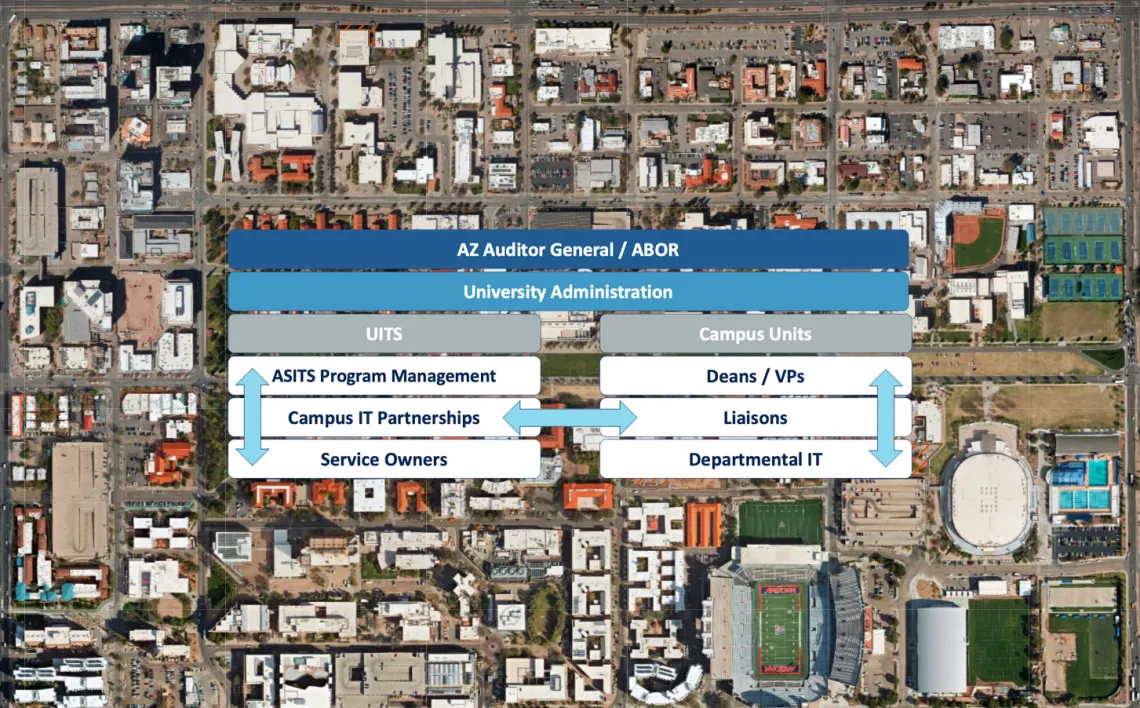Inventories Capture Campus IT Environment
Campus IT staff document their units’ services for migration

The University’s 72 colleges and divisions and UITS will be working together to reshape and strengthen campus IT operations, security, and services over the next two plus years. The first step in the Accelerating Secure IT Services program was capturing which elements of the program each of the 72 units will need to implement.
These include:
- Removing our dependency on aging hardware by moving on-premises servers to the cloud where feasible
- Streamlining our computer management experience for faculty and staff by enrolling into the Technology Lifecycle Care program
- Securing our campus network and ensuring that connection to the wider internet is secured and fully managed by UITS
These projects may include additional work, such as joining the BlueCat active directory domain or replacing departmental email with the campus email system.
Each Dean and VP designated IT liaisons to represent and work on behalf of their unit. There are now 36 primary liaisons and 36 alternate liaisons representing campus units with UITS Campus IT Partnerships. (Some liaisons are working with more than one unit; 22 campus units have IT support provided by UITS.)
In early January, liaisons received a Transition Planning Toolkit with directions, timelines and available resources. The toolkit is a template for developing an inventory of all the IT assets that are managed by each unit, including private networks, servers, and workstations. The data will be used to plan migrating responsibility for infrastructure to UITS-managed services. These inventories are the first step in understanding the information technology environment at the University of Arizona.
ASITS held monthly meetings and two drop-in office hours weekly to support the liaisons throughout the toolkit data collection process. The named IT Liaisons and the ASITS Project Team also have a private channel within the UArizona IT Coordination Microsoft Team as a central resource to find answers, support and past meeting recordings.
UITS service owners also host office hours. Mike Morris, IT Liaison from and Senior Director of IT for the College of Science, said that he has visited office hours for all of them. “It’s really convenient to be able to drop in and ask any questions I have.”
The unit liaisons submitted their Toolkits on February 24. Mike pointed out, “Each of these toolkits represents hundreds of hours of work from the liaisons and the other IT staff who helped them gather information.” He added that the process benefitted everyone, though. “IT staff will appreciate having a solid inventory documented for their unit.”
Campus IT Partnerships and the UITS service owners are now analyzing this data and mapping it to UITS services, based on the data collected. This initial analysis will be the basis for further discussions with each unit. UITS is making it a priority to ensure transparency and engagement with the campus throughout this process.
UITS subject matter experts and business analysts, Campus IT Partnerships, service project managers, and campus liaisons, will collaborate on a proposed migration plan with dates for all 72 units by the end of May. By mid-June, ASITS hopes to have signed agreements with each unit on their plan and timeline.
The campus liaisons are assigned a senior implementation analyst in Campus IT Partnerships, also called a “navigator,” to be their main point of contact throughout the process. CITP executive director Maysoon Eshelman explained, “We have 9 navigators to help the liaisons and their departments get onboarded to appropriate services. They’re there to create transparency throughout this process. We’ve had to move very quickly on getting this program launched. Because of this, it is critical that the campus feels engaged and informed as we move forward.”
Maysoon described the role of the navigators as advocates for the college or division—to understand their unit’s business requirements, listen for and help to address potential challenges, and to answer some common technical questions. Within UITS, the navigators will work closely with the ASITS team and project managers to ensure that work is routed to the appropriate service managers and teams.
Once the migration calendar and plans are in place, ASITS will incorporate change management best practices into its work with units, in concert with the liaisons and navigators. Throughout the migrations, UITS wants to communicate effectively and ensure questions and requirements from departments are being heard. Clear communications will be important as units transition to the shared responsibility model, and to develop a framework for future sustained collaborations between UITS and campus units.
For questions about the ASITS Program, please contact uits-asits@arizona.edu.

